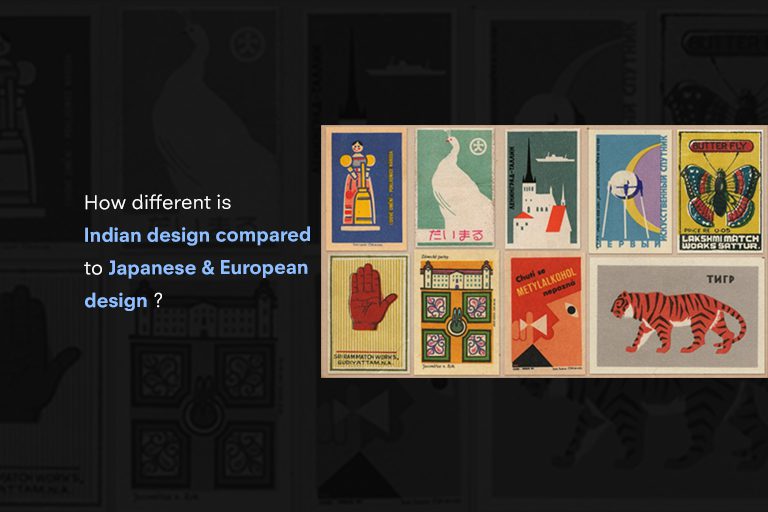Culture, society and the economic climate plays a dominant role in defining the crux of what a design industry is largely influenced by. They help to build a unique identity around each country with respect to their design industry’s focus, their pillars, artistic visual inspiration, language and typography used, dominance of certain color over others, symbols among the other things.
Also read: Shift from human centric design to humanity centric design
While what may work as a great design in one country, may not be considered as ‘great’ design in another. What resonates with the Japanese audience, will not necessarily resonate with the Indian or the European.
Design from an Indian viewpoint..
India has always been about a collective group, a cultural celebration, a religious belief with its vast landscape, agriculture, horticulture and animal farming accounting for the majority of the jobs and influences. While the west works with the concept of individualism, in India the design is more focused with the idea of collectivism.
From images of groups, formal languages and symbols, and more, Indian design tends to be more inspired from its own culturally rich heritage and visually high emphasis paid on colors for certain products categories (like in fashion and certain lifestyle items, Indian designers use a lot of bright colors like red, green, orange, hot pink among others). Loud design, with a lot of intricate detailing, bold colors with highlights and multiple elements to focus on- represents the Indian design to some extent.
Another important aspect is how Indian culture is highly entwined with spirituality that can be seen embodied in Indian interior design and aesthetics space. From reviving India arts and craft, design has always been reflecting the economic conditions of the times, from displaying animals on block printed fabrics, to perfectly crafted, designed and carved shapes in product design (furniture especially) that the royal families of India owned. One major highlight is how the design also changes with in India from one state to another, Goa will offer your more Portuguese inspired designs with pop colors and eccentricity at core while Rajasthan will to light the heritage opulence with earth tones, more classic design and one of its kind pieces, in product design to architecture and vehicles.
Read more: Influence of covid on design trends
Design from a Japanese viewpoint..
While at one point Japanese design is considered to be minimalist, on the other hand graphic design and caricature design has been known to be bold, quirky and rather highly eccentric – all coming from Japan. Many experts have been noted to say how Japanese design can be viewed as more information dense and hence may seem cluttered to people from European nations, who will not be able to connect with it.
Manga design is one of the most popular design concepts from Japan. Manga is essentially a Japanese art form that encompasses drawn cartoons, graphic novels and comic books. That is also how they are very relatable globally. This gave rise to a whole culture of bold brushstrokes, bright colors, cute mascots that also made it more relatable for the common man to connect with.
Japanese design core lies in details, they view the detailing as part of their communication and therefore is a crucial part of their design elements.
Mixing languages with design is one of the common practices that graphic designers use in Japan. As an example, mixing Roman characters with Japanese is a popular trend. Another one is the use of English text with Japanese text/ characters. A practice not so common in Indian design or European where the focus is more on vernacular content.
Read more: How metaverse is going to change the way you design things
Design from a Northern European viewpoint
North European countries are also known as Scandinavian countries that include countries like Denmark, Sweden, Norway and few others. Design aesthetics here are defined as being minimalist, with clean simple and crisp lines. These are known to be highly functional designs without many heavy elements, only what is necessary and still being style effective.
With the weather conditions in these Scandinavian countries, the survival aims to be more functional and this has become the basis of their design. A striking contrast from what design is in India or Japan, where more is always good.
Scandinavian design is also highly inspired from a large series of art movements and often also referred to as democratic design with its focus and aim to appeal to masses with products that have noteworthy style quotient but are also affordable and accessible. Some of their ideologies come from long established societies and institutions such as the Swedish Society of Industrial Design.
Read more: 10 design blogs to follow
We can understand how each place has its own unique geography, art movements, cultural heritage and value systems to icons that they are inspired by and how all this impacts what people in India or any other country would relate to more from a design. Making it impossible for a single design sometimes to remain as effective worldwide as it may be in one country.
Read more: Top trends shaping the UX design industry



Want to Become a Designer ?
Strate is a unique design school that nurtures your talents as a designer by offering state-of-the art designing courses in Bangalore.
Join Strate